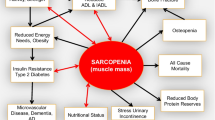Abstract
Roy Walford, a physician and scientist who pioneered research on the anti-aging effects of caloric restriction and subjected himself to a low-energy diet, recently died from amyotrophic lateral sclerosis (ALS). Information from his case, epidemiological findings, and recent controlled studies in mouse models of ALS suggest that low-energy diets might render motor neurons vulnerable to degeneration, whereas high-energy diets are ameliorative. This contrasts with the effects of low-energy diets on various neuronal populations in the brain that respond adaptively, activating pathways that promote plasticity and resistance to disease. One reason that motor neurons might be selectively vulnerable to low-energy diets is that they are unable to engage neuroprotective responses to energetic stress response involving the protein chaperones, such as, heat-shock protein-70.
Similar content being viewed by others
References
Batulan Z., Shinder G. A., Minotti S., et al. (2003) High threshold for induction of the stress response in motor neurons is associated with failure to activate HSF1, J. Neurosci. 23, 5789–5798.
Desport J. C., Preux P. M., Truong T. C., Vallat J. M., Sautereau D., and Couratier P. (1999) Nutritional status is a prognostic factor for survival in ALS patients. Neurology 53, 1059–1063.
Desport J. C., Preux P. M., Magy L., et al. (2001) Factors correlated with hypermetabolism in patients with amyotrophic lateral sclerosis. Am. J. Clin. Nutr. 74, 328–334.
Duan W., Guo Z., Jiang H., Ware M., Li X. J. and Mattson M. P. (2003) Dietary restriction normalizes glucose metabolism and BDNF levels, slows disease progression, and increases survival in huntingtin mutant mice. Proc. Natl. Acad. Sci. USA 100, 2911–2916.
Dupuis L., Oudart H., Rene F., Gonzalez de Aguilar J. L., and Loeffler J. P. (2004) Evidence for defective energy homeostasis in amyotrophic lateral sclerosis: benefit of a high-energy diet in a transgenic mouse model. Proc. Natl. Acad. Sci. USA 101, 11,159–11,164.
Hamadeh M. J. Rodriquez M. C., Kaczor J. J., and Tarnopolsky M. A. (2005) Caloric restriction transiently improves motor performance but hastens clinical onset of disease in the Cu/Zn-superoxide dismutase mutant G93A mouse. Muscle Nerve 31, 214–220.
Kasarskis E. J. and Winslow M. (1989) When did Lou Gehrig’s personal illness begin?, Neurology 39, 1243–1245.
Klivenyi P., Ferrante R. J., Matthews R.T., et al. (1999) Neuroprotective effects of creatine in a transgenic animal model of amyotrophic lateral sclerosis. Nat. Med. 5, 347–350.
Kurzke J. F. (1982) Epidemiology of amyotrophic lateral sclerosis. Adv. Neurol. 36, 281–302.
Lassinger B. K. Kwak C., Walford R. L., and Jankovic J. (2004) Atypical parkinsonism and motor neuron syndrome in a Biosphere 2 participant: a possible complication of chronic hypoxia and carbon monoxide toxicity. Movement Disorders 19, 465–469.
Majoor-Krakauer D., Willems P. J., and Hofman A. (2003) Genetic epidemiology of amyotrophic lateral sclerosis. Clin. Genet. 63, 83–101.
Maswood N., Young J., Tilmont E., et al. (2004) Caloric restriction increases neurotrophic factor levels and attenuates neurochemical and behavioral deficits in a primate model of Parkinson’s disease. Proc. Natl. Acad. Sci. USA 101, 18,171–18,176.
O’Connor A. (2004) New York Times, May 4, 2004. http://wwwpathnet.medsch.ucla.edu/department/ news_announcements/walford_endowedlecture ship/NYTimes.htm.
Okado-Matsumoto A. and Fridovich I. (2002) Amyotrophic lateral sclerosis: a proposed mechanism. Proc. Natl. Acad. Sci. USA 99, 9010–9014.
Petel N. V., Gordon M. N., Connor K. E., et al. (2005) Caloric restriction attenuates A beta-deposition in Alzheimer transgenic models. Neurobiol. Aging 26, 995–1000.
Pedersen W. A., and Mattson M. P. (1999) No benefit of dietary restriction on disease onset or progression in amyotrophic lateral sclerosis Cu/Zn-superoxide dismutase mutant mice. Brain Res. 833, 117–120.
Scarmeas N., Shih T., Stern Y., Ottman R., and Rowland L. P. (2003) Premorbid weight, body mass, and varsity athletics in ALS. Neurology 59, 773–775.
Sinclair D. A. (2005) Toward a unified theory of caloric restriction and longevity regulation. Mech. Ageing Dev. 126, 987–1002.
Veldink J. H., Kalmijn S., Groeneveld G. J., Titulaer M. J., Wokke J. H., and van den Berg L. H. (2005) Physical activity and the association with sporadic ALS. Neurology 64, 241–245.
Walford R. L. (1985) The extension of maximum life span. Clin. Geriatr. Med. 1, 29–35.
Walford R. L., Mock D., Verdery R., and MacCallum T. (2002) Calorie restriction in biosphere 2: alterations in physiologic, hematologic, hormonal, and biochemical parameters in humans restricted for a 2-year period. J. Gerontol. A Biol. Sci. Med. Sci. 57, B211-B224.
Yu Z. F. and Mattson M. P. (1999) Dietary restriction and 2-deoxyglucose administration reduce focal ischemic brain damage and improve behavioral outcome: evidence for a preconditioning mechanism. J. Neurosci. Res. 57, 830–839.
Author information
Authors and Affiliations
Corresponding author
Rights and permissions
About this article
Cite this article
Mattson, M.P., Cutler, R.G. & Camandola, S. Energy intake and amyotrophic lateral sclerosis. Neuromol Med 9, 17–20 (2007). https://doi.org/10.1385/NMM:9:1:17
Received:
Accepted:
Issue Date:
DOI: https://doi.org/10.1385/NMM:9:1:17




